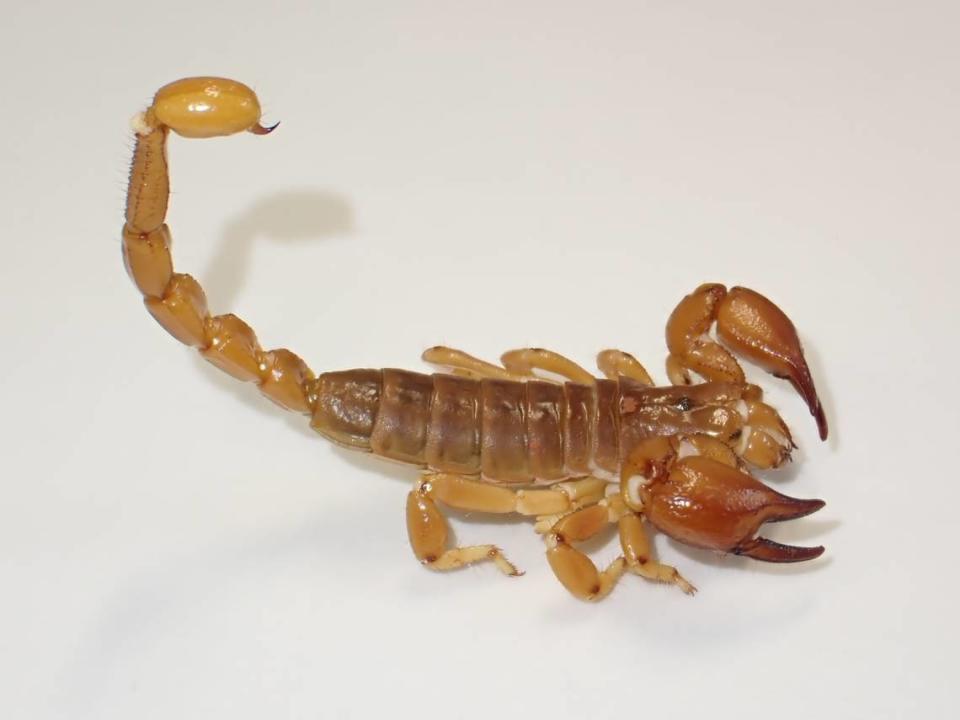‘Large’ creature — with ‘strangely shaped’ tail tip — is new venomous species. See it
Researchers trekked through the dry and rocky landscape of north Western Australia, using ultraviolet light tools to scan for creatures that might be in the area. That’s when they spotted a yellow, eight-legged arachnid and plucked it from a drainage line.
The team was searching for scorpions in the Pilbara region, according to a study published Nov. 3 in the Australian Journal of Zoology.
After collecting specimens from traps and drainage lines throughout the area, researchers said they had discovered an “unusual” new species of burrowing scorpion. But as they took a closer look at the creatures, and began examining the anatomy of their genitalia, they found that some of the specimens weren’t the same.
Researchers had actually found two new identical species only distinguishable by their genitalia. The new species are known as Urodacus uncinus and Urodacus lunatus, scientists said.

Discover more new species
Thousands of new species are found each year. Here are three of our most eye-catching stories from the past week.
→ Carnivorous flying saucer creature — with ‘blade-shaped’ teeth
→ ‘Large’-eyed mountain creature found hiding in stream in China
→‘Shining blue’ creature — with ‘false head’ — found basking in sun
“By also looking at their internal genitalia, rather than only the external morphology, we discovered what we initially thought was one strange species — quite distinctive from other known Urodacus species — was actually two new unusual species,” lead author Bruno Buzatto said in a Jan. 16 Flinders University news release.
Urodacus are a type of scorpion native to Australia’s mainland, Buzatto and Erich S. Volschenk, one of the study’s co-authors, wrote in a piece for The Conversation. The species live in “deep spiralling burrows, allowing them to survive in arid ecosystems.”
The two new species are “large” scorpions, measuring nearly 3 inches, Buzatto and Volschenk said.
Researchers examined 16 specimens of Urodacus uncinus, both males and females, and nine male specimens of Urodacus lunatus, according to the study. Both species are known to live in creeks and drainage lines.
Male specimens of the two species have different hemispermatophores, which are structures covering the scorpions’ abdomens to protect their spermatophore, scientists said. Males use their spermatophore to transfer sperm to females during mating.
While Urodacus uncinus have a “conical” structure in their hemispermatophore, Urodacus lunatus have a “waxing crescent half moon” structure, experts said. In fact, Urodacus lunatus was named after the Latin word meaning “crescent shaped” in reference to the structure.
The “strange” new species differ from other burrowing scorpions by their “remarkable” and “strangely shaped” tails, according to researchers.
“Males of both species have a striking enlargement in the tip of their ‘tails,’ with a swollen venom gland and a sting that is more strongly curved than in any other known species of the genus,” Buzatto and Volschenk said.
Urodacus uncinus was named after the Latin word for “hook” after its curved sting, also known as its aculeus, scientists said.
Researchers said the “rare” creatures’ mating behavior is still unclear, and there is still more research to be done. The scorpions’ stings seem to be benign to humans.
“So far, we only know these two new species have a narrow range in the Pilbara, restricted to creeks and drainage lines, so we need to investigate their habitat requirements a bit more in future research,” Buzatto said.
Carnivorous flying saucer creature — with ‘blade-shaped’ teeth — is a new species
Jumping creature spins ‘sheets of web’ and tucks self in at night. It’s a new species
Mountain critter with ‘distinct’ pattern — found hidden in stream — is new species

